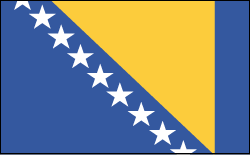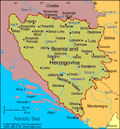Bosnia and Herzegovina
Presidency: Zeljko Komsic (Bosnian Croat, 2006), Bakir Izetbegovic (Bosniak, 2010), Nebojsa Radmanovic (Bosnian Serb, 2006)
Prime Minister: Vjekoslav Bevanda (2012)
Total area: 19,741 sq mi (51,129 sq km)
Population (2012 est.): 4,622,292) (growth rate: -0.003%); birth rate: 8.89/1000; infant mortality rate: 8.47/1000; life expectancy: 78.96
Capital and largest city (2009 est.):Sarajevo, 392,000
Monetary unit: Marka
National Name: Bosna i Hercegovina
Current government officials
Languages: Bosnian, Croatian, Serbian
Ethnicity/race: Bosniak 48%, Serb 37.1%, Croat 14.3%, other 0.6% (2000)
National Holiday: National Day, November 25
Religions: Islam 40%, Orthodox 31%, Roman Catholic 15%, other 14%
Literacy rate: 96.7.
Economic summary: GDP/PPP (2011 est.): $31.72 billion; per capita $8,200.Real growth rate: 2.2%. Inflation:3.8%. Unemployment: 43.3% official rate. Arable land: 19.61%.Agriculture: wheat, corn, fruits, vegetables; livestock. Labor force: 2.6 million (2010); agriculture 20.5%, industry 32.6%, services 47%Industries: steel, coal, iron ore, lead, zinc, manganese, bauxite, vehicle assembly, textiles, tobacco products, wooden furniture, tank and aircraft assembly, domestic appliances, oil refining. Natural resources: coal, iron ore, bauxite, copper, lead, zinc, chromite, cobalt, manganese, nickel, clay, gypsum, salt, sand, forests, hydropower. Exports: $5.579 billion (2011 est.): metals, clothing, wood products. Imports: $10.38 billion (2011 est.): machinery and equipment, chemicals, fuels, foodstuffs. Major trading partners: Italy, Croatia, Germany, Austria, Slovenia, Hungary (2010).
Communications: Telephones: main lines in use: 998,600 (2010); mobile cellular: 3.014 million (2010).Broadcast media: 3 public TV broadcasters: Radio and TV of Bosnia and Herzegovina, Federation TV (operating 2 networks), and Republika Srpska Radio-TV; a local commercial network of 5 TV stations; 3 private, near-national TV stations and dozens of small independent TV stations broadcasting; 3 large public radio broadcasters and a large number of private radio stations (2010). Internet hosts: 146,152 (2011). Internet users:1.422 million (2009).
Transportation: Railways: total: 601 km (electrified 392 km) (2009).Highways: total: 22,926 km; paved: 19,426 km; unpaved: 3,500 km (2010).Waterways: Sava River (northern border) open to shipping but use limited (2009). Ports and terminals:Bosanska Gradiska, Bosanski Brod, Bosanski Samac, and Brcko (all inland waterway ports on the Sava), Orasje.Airports: 25 (2010).
International disputes: Serbia delimited about half of the boundary with Bosnia and Herzegovina, but sections along the Drina River remain in dispute.
Major sources and definitions |
 |
Geography | Government | History
Geography
Bosnia and Herzegovina make up a triangular-shaped republic, about half the size of Kentucky, on the Balkan peninsula. The Bosnian region in the north is mountainous and covered with thick forests. The Herzegovina region in the south is largely rugged, flat farmland. It has a narrow coastline without natural harbors stretching 13 mi (20 km) along the Adriatic Sea.
Government
Emerging democracy, with a rotating, tripartite presidency divided between predominantly Serb, Croatian, and Bosnian political parties.
History
Called Illyricum in ancient times, the area now called Bosnia and Herzegovina was conquered by the Romans in the 2nd and 1st centuries B.C.and folded into the Roman province of Dalmatia. In the 4th and 5th centuries A.D., Goths overran that portion of the declining Roman Empire and occupied the area until the 6th century, when the Byzantine Empire claimed it. Slavs began settling the region during the 7th century. Around 1200, Bosnia won independence from Hungary and endured as an independent Christian state for some 260 years.
The expansion of the Ottoman Empire into the Balkans introduced another cultural, political, and religious framework. The Turks defeated the Serbs at the famous battle of Kosovo in 1389. They conquered Bosnia in 1463. During the roughly 450 years Bosnia and Herzegovina were under Ottoman rule, many Christian Slavs became Muslim. A Bosnian Islamic elite gradually developed and ruled the country on behalf of the Turkish overlords. As the borders of the Ottoman Empire began to shrink in the 19th century, Muslims from elsewhere in the Balkans migrated to Bosnia. Bosnia also developed a sizable Jewish population, with many Jews settling in Sarajevo after their expulsion from Spain in 1492. However, through the 19th century the term Bosnian commonly included residents of all faiths. A relatively secular society, intermarriage among religious groups was not uncommon.
Neighboring Serbia and Montenegro fought against the Ottoman Empire in 1876 and were aided by the Russians, their fellow Slavs. At the Congress of Berlin in 1878, following the end of the Russo-Turkish War (1877–1878), Austria-Hungary was given a mandate to occupy and govern Bosnia and Herzegovina, in an effort by Europe to ensure that Russia did not dominate the Balkans. Although the provinces were still officially part of the Ottoman Empire, they were annexed by the Austro-Hungarian Empire on Oct. 7, 1908. As a result, relations with Serbia, which had claims on Bosnia and Herzegovina, became embittered. The hostility between the two countries climaxed in the assassination of Austrian archduke Franz Ferdinand in Sarajevo on June 28, 1914, by a Serbian nationalist. This event precipitated the start of World War I (1914–1918). Bosnia and Herzegovina were annexed to Serbia as part of the newly formed Kingdom of Serbs, Croats, and Slovenes on Oct. 26, 1918. The name was later changed to Yugoslavia in 1929.
When Germany invaded Yugoslavia in 1941, Bosnia and Herzegovina were made part of Nazi-controlled Croatia. During the German and Italian occupation, Bosnian and Herzegovinian resistance fighters fought a fierce guerrilla war against the Ustachi, the Croatian Fascist troops. At the end of World War II, Bosnia and Herzegovina were reunited into a single state as one of the six republics of the newly reestablished Communist Yugoslavia under Marshall Tito. His authoritarian control kept the ethnic enmity of his patchwork nation in check. Tito died in 1980, and with growing economic dissatisfaction and the fall of the iron curtain over the next decade, Yugoslavia began to splinter.
In Dec. 1991, Bosnia and Herzegovina declared independence from Yugoslavia and asked for recognition by the European Union (EU). In a March 1992 referendum, Bosnian voters chose independence, and President Alija Izetbegovic declared the nation an independent state. Unlike the other former Yugoslav states, which were generally composed of a dominant ethnic group, Bosnia was an ethnic tangle of Muslims (44%), Serbs (31%), and Croats (17%), and this mix contributed to the duration and savagery of its fight for independence.
Ethnic Antgonism Erupts in War
Both the Croatian and Serbian presidents had planned to partition Bosnia between themselves. Attempting to carve out their own enclaves, the Serbian minority, with the help of the Serbian Yugoslav army, took the offensive and laid siege, particularly on Sarajevo, and began its ruthless campaigns of ethnic cleansing, which involved the expulsion or massacre of Muslims. Croats also began carving out their own communities. By the end of Aug. 1992, rebel Bosnian Serbs had conquered over 60% of Bosnia. The war did not begin to wane until NATO stepped in, bombing Serb positions in Bosnia in Aug. and Sept. 1995. Serbs entered the UN safe havens of Tuzla, Zepa, and Srebrenica, where they murdered thousands. About 250,000 died in the war between 1992 and 1995.
U.S.-sponsored peace talks in Dayton, Ohio, led to an agreement in 1995 that called for a Muslim-Croat federation and a Serb entity within the larger federation of Bosnia. Sixty thousand NATO troops were to supervise its implementation. Fighting abated and orderly elections were held in Sept. 1996. President Izetbegovic, a Bosnian Muslim, or Bosniak, won the majority of votes to become the leader of the three-member presidency, each representing one of the three ethnic groups.
But this alliance of unreconstructed enemies had little success in creating a working government or keeping violent clashes in check. The terms of the Dec. 1995 Dayton Peace Accord were largely ignored by Bosnian Serbs, with its former president, arch-nationalist Radovan Karadzic, still in de facto control of the Serbian enclave. Many indicted war criminals, including Karadzic, remain at large. NATO proved to be a largely ineffective peacekeeping force.
After the Dayton Peace Accord, Challenges Remain
The crucial priorities facing postwar Bosnian leaders were rebuilding the economy, resettling the estimated one million refugees still displaced, and establishing a working government. Progress on these goals has been minimal, and a massive corruption scandal uncovered in 1999 severely tested the goodwill of the international community.
In 1994, the UN's International Criminal Tribunal for the former Yugoslavia opened in The Hague, Netherlands. In Aug. 2001, Radislav Drstic, a Bosnian Serb general, was found guilty of genocide in the killing of up to 8,000 Bosnian Muslims in Srebrenica in 1995. It was the first genocide conviction in Europe since the UN genocide treaty was drawn up in 1951. In 2001, the trial of former Serbian president Slobodan Milosevic began. He was charged with crimes against humanity. The expensive and lengthy trial ended without a verdict when he died in March 2006.
Under pressure from Paddy Ashdown, the international administrator of Bosnia authorized under the Dayton Accord, Bosnian Serb leaders finally admitted in June 2004 that Serbian troops were responsible for the massacre of up to 8,000 Bosnian Muslims in Srebrenica in 1995. Until then, Serb leaders had refused to acknowledge guilt in the worst civilian massacre since World War II. In Feb. 2007, the International Court of Justice ruled that the massacre was genocide, but stopped short of saying Serbia was directly responsible. The decision spared Serbia from having to pay war reparations to Bosnia. The court's president, Judge Rosalyn Higgins, however, criticized Serbia for not preventing the genocide. The court also ordered Serbia to turn over Bosnian Serb leaders, including Ratko Mladic and Radovan Karakzic, who are accused of orchestrating the genocide and other crimes. Bosnians expressed disappointment with the ruling; they had demanded that Serbia pay war reparations.
In Dec. 2004, the European Union officially took over NATO's peacekeeping mission in Bosnia. It is the largest peacekeeping operation the EU has undertaken. In March 2005, Ashdown, the international administrator, sacked Dragan Covic, the Croat member of the presidency, charging him with corruption and abuse of office. Covic became the third member of the Bosnian presidency forced to resign since the tripartite presidency was established.
Small Steps Toward Inclusion in the EU
Elections in Oct. 2006 reinforced the lingering ethnic tensions in the country. The Serbian coalition, which favors an independent state, narrowly defeated the Muslim-Croat Federation that prefers moving toward a more unified country. In January 2007, Bosnian Serb Nikola Spiric took over as prime minister and formed a new government. He resigned in Nov. 2007 to protest reforms introduced by an international envoy, who was appointed under the Dayton Accords by the UN and the European Union and has the power to enact legislation and dismiss ministers. Spiric said the reforms, which the EU said would help the country's entrance into the organization, would diminish the influence of Bosnian Serbs and enhance those of other ethnic groups. Crisis was averted later in November, when Spiric and the country's Croat and Muslim leaders agreed on a series of reforms approved by Parliament.
On July 21, 2008, Radovan Karadzic, the Bosnian Serb president during the war in Bosnia in the 1990s, was charged with genocide, persecution, deportation, and other crimes against non-Serb civilians. Karadzic orchestrated the massacre of almost 8,000 Muslim men and boys in 1995 in Srebrenica. He was found outside Belgrade. The arrest will likely bring Serbia closer to joining the European Union.
Since the presidential and parliamentary elections in 2010, Bosnia had been in a political deadlock, without a government. In Dec. 2011, the Bosniak, Serb and Croatian communities successfully produced a government, bringing the country a little closer to EU membership.
See also Encyclopedia: Bosnia and Herzegovina
U.S. State Dept. Country Notes: Bosnia and Herzegovina
Agency for Statistics www.bhas.ba/ .
U.S. State Dept. Country Notes: Bosnia and Herzegovina
Agency for Statistics www.bhas.ba/ .

No comments:
Post a Comment